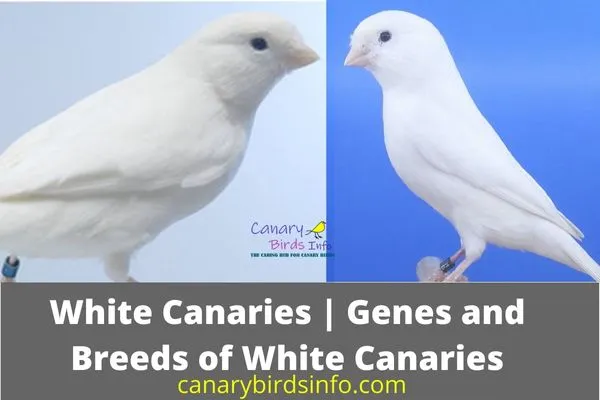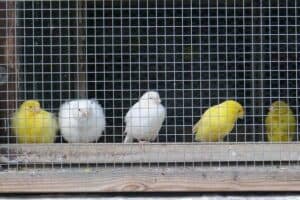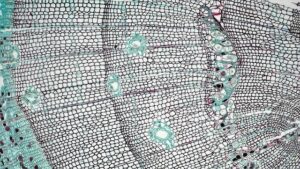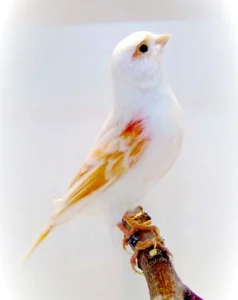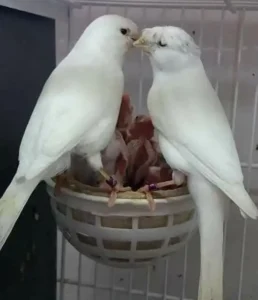White Canaries
What are white canaries? White canaries are one of the most beautiful colors found in the canaries. The white color of their feathers, make this singing bird more beautiful and lovely.
White canaries show canary birds and as well as singing canary birds. White canaries sing like other canaries and are paired the same as other canaries. However, the white color of the canaries is not the base or natural main color of this bird.
As we have researched and detailed about the canary colors and the different types of colors in canaries in an article, where you know that the basic and main color of this beautiful singing bird is green and yellow.
However, with the passage of time and pairing various canaries, feeding them with different food and vitamin supplements, various color canaries resulted including white canaries.
Pure white canaries when paired with pure white, the resultant breed is of the same color. 99% chances are of the same color. However, if genetically any one of the canaries either male or female had different colors in ancestral, the shades of those ancestral may appear on wings and tails. Sometimes, the head may show the shaded colors as well.
Want to know more about the canary colors, Read here in detail
Albino Canaries or White Canaries
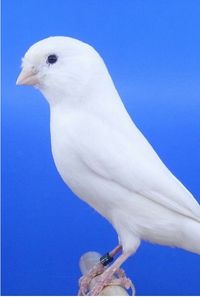
Genetics behind the Color Breed of White Canaries
Both the melanin and lipochrome varieties of the birds are divided into two parentages. Black canaries are melanin and clear canaries are lipochrome. The original canary was of the melanin variety. Blue, yellow, gold, and dark green birds make up the lipochromes.
For anyone who wants to know the genetics behind such complicated traits as the canary’s colors, a college biology degree is essential. People generally understand a bird’s phenotype, but they don’t realize that the genotype is the biological description of an organism. Not knowing the genotype of a specimen means not knowing its ancestry or pedigree. It also means that we can’t predict the colors of nestlings.
So, if you have proper knowledge about Genetics/DNA, it would be easier for you to understand what colors offspring will produce.
The DNA is as it is because of the characteristics of its components. These characteristics include size, number, shape, and similar traits of genes, and genes are located on chromosomes. Each chromosome has a specific number of spots where genes are located which cause each organism to have its unique set of characteristics, such as eye color and physical appearance.
Each pair of chromosomes of each organism has the same pairs of spots, but they are located on each chromosome in different places. Geneticists compare the spots on the two chromosomes to understand how organisms develop and change.
Since we can recognize a hybrid by the different genes that it has, we count the single genes that come from the father and the mother. Although we don’t know which parent passed which gene on, we know that they have both colors from their own genes. So we can predict the appearance of the babies. We can also use charting to predict which color will appear in the nest.
When new feathers are forming, a wild canary will generate melanin from proteins in its food. Melanin will be absorbed by feathers and color the new feathers. If the source of food is poor, the color will be darker than it would normally be. The bird called a clear canary will produce melanin without using the proteins in its food. Lipochrome is defective in the clear canary; it cannot produce melanin and makes the new feathers black instead of white. So, this mutation on the lipochrome gene is classified as an incomplete dominant.
There is no good reason to produce safe variegated canaries in the color bred. Mixed-colored birds are attractive in certain varieties, but they won’t do well as color breed in the United States because it is illegal here to cross the color bred with variegated birds. Some experts claim that color bred with clear birds will lose vitality and color. This is not true, but melanin cannot be bred from clear birds. Pairing clear to melanin or variegated unleashes a number of problems. Many clear birds that appear variegated turn out to have tics and dark spots on their legs, spurs, and feet. Mixed-color figures often take time to age to appear variegated.
Black and white canaries differ in genetic material. A dominant white canary is one that has only one gene to produce the white color. A yellow canary has two different genes, one gene producing the white color and the other producing the yellow color.
Some breeders breed recessive white individuals to create a new color, such as blue or green. This pairing gives 50% offspring, where the sicker color is chosen. The mating of recessive white canaries to yellow carriers of recessive white causes a sicker yellow, and 50% sicker white. These salmonagists assume that the mating of recessive white to recessive white will cause a decline in the health and vitality of the specific sex of the offspring.
Many canary breeders claim that young, recessive white canaries need more nutritional volume than other canary varieties to survive. The canaries, however, do quite well with the proper nutritional products and care. This is the same as for all other finches.
The recessive white mutation removes all color. It causes white birds to retain their wild-type appearance forever. The occasional recessive white can be color-negged, and the resulting combination will result in birds that are white with marked coloration.
Some years ago, when the recessive white was used, it was thought that it carried no genes for yellow production. When crosses are made between the marked red and the recessive white-capped groups, however, the recessive white gene masks the yellow genes. That means you can still see small hints of yellow in the pure red and the red with the recessive white, but the recessive white gene makes the dominant yellow genes inoperative. Dominant canaries show slight shading of yellow in the flights.
Pairing and Breeding White Canaries
White canaries are paired the same as other canaries. Breeding white canaries involves all those processes which you adopt for a normal canary pair. The only thing is to have both males and females of the same color or gene so that resultant chicks may be of white color.
Caring
A white canary bird needs the same care as other birds. Their seeds or food supplement is not different than normal canary birds. The white canary bird is attractive and beautiful where it’s suggested to shower or keep a tub of water in the cage for a regular bath.
In addition, calcium and vitamins are also necessary for this beautiful bird like yellow, orange, or green canary.
Cage for White Canary
The cage for the white canary should be of the same size but with contrasting color. A white cage is not suggested for a white canary bird if you want to enjoy the beauty of this bird. However, a dark color cage will be ideal.
In Sum, if you are too curious and careful to breed only white canaries, or have pure white canaries, it is important to know the genes of white canaries, and their parents so that you will get a pure breed.
Moreover, caring for and feeding the white canary birds is not different than other canary birds. If you have experience owning other color canaries, it won’t be difficult to have a white canary as your pet.
Please let me know if you want to know anything else regarding white canaries.

